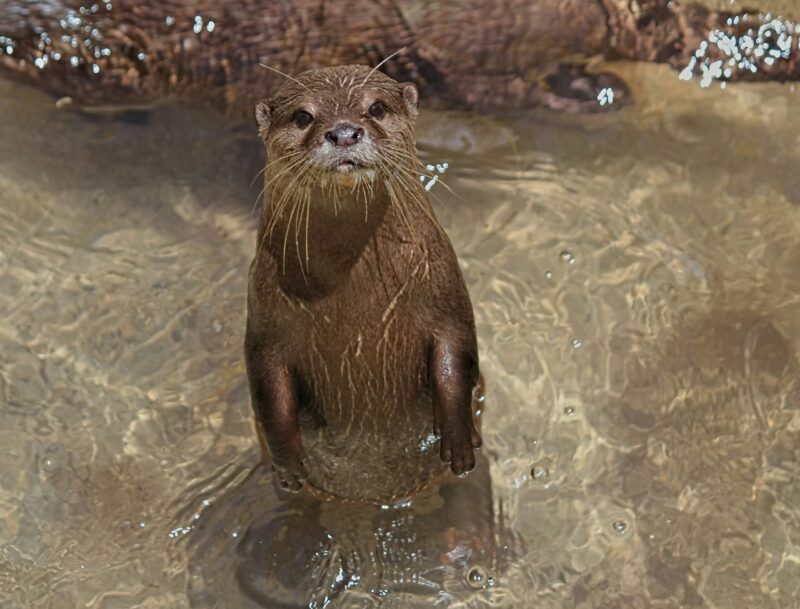
Otters are mammals that belong to the mustelid family (Mustelidae). They share a category with the weasel, the badger and the mink, among others. Most are small, with short ears and noses, elongated bodies, long tails, and soft, dense fur. Due to this cute appearance and, of course, a playful attitude, many people have fallen in love with these animals. Read some interesting facts about them here.
To date, 13 species of otters have been identified. Their sizes vary from about 20 to 70 inches (60 to 180 cm) and their weight ranges from about 45 to 65 pounds (20 to 30 kg). Their lifespan is up to 12 years.
Where to find them and feeding habits
Otters are found worldwide except for Australia and Antarctica. They live on both land and water, although they spend most of their time in water. Most of them live in freshwater rivers, lakes, and wetlands, but sea otters are found in the Pacific Ocean.
They are carnivorous mammals that feed on whatever is easiest to obtain. So, their diet often varies seasonally or locally depending on what prey is available. Otters have fangs and molars that help them hunt and feed on meat.
In freshwater ecosystems, they feed on a wide variety of prey such as fish, crabs, mussels, mollusks, crustaceans, small mammals, birds and frogs. Sea otters eat a wide range of marine animals, including mussels, clams, urchins, crabs, snails and around 40 other marine species. In addition, otters are greedy for food and feed almost all day, consuming between 15% and 25% of their body weight each day.

Otter anatomy
Otters use their eyesight to chase fish, and their mouths and front legs to hunt them. They also use their manual dexterity to search for crayfish among the rocks. Sight is their most important sense when hunting. They can even correct the refraction caused by the change from the terrestrial environment to the aquatic environment. Simply amazing.
Likewise, they have sensory hairs on their snout, called vibrissae. These are stiff hairs, or whiskers, that some animals (especially mammals) have as a tactile, sensory element that helps them hunt. The vibrissae have sensitive roots that allow land animals to detect air currents, and aquatic animals to detect vibrations in the water.
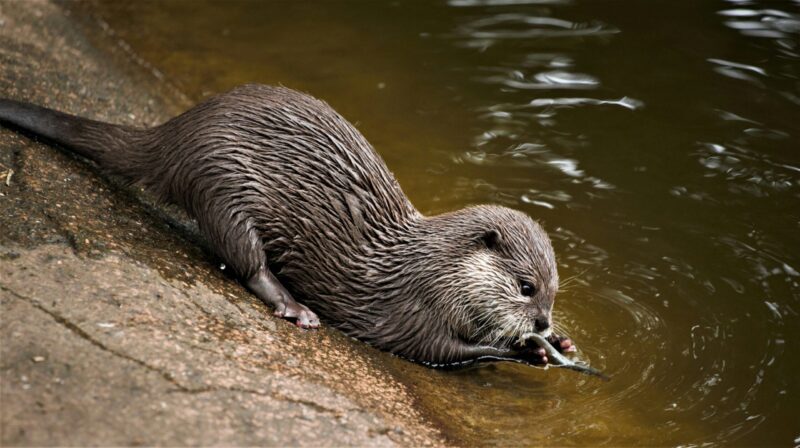
After an otter captures its prey between the teeth or front legs, the prey is consumed in the water or on the shore. River otters hunt best in shallow water, although they are good swimmers. In fact, these animals are capable of diving up to 100 feet (30 meters) deep. They can even reach a speed of up to 9 miles per hour (14 kph) and can stay underwater without breathing for up to 8 minutes.
Their powerful hind legs are long, flattened and completely webbed; that anatomy helps them propel themselves through the water. They even have a fifth toe that helps them swim more easily, although it makes it difficult for them to move on land. The front legs are short and have retractable claws, which are useful to grab slippery prey.
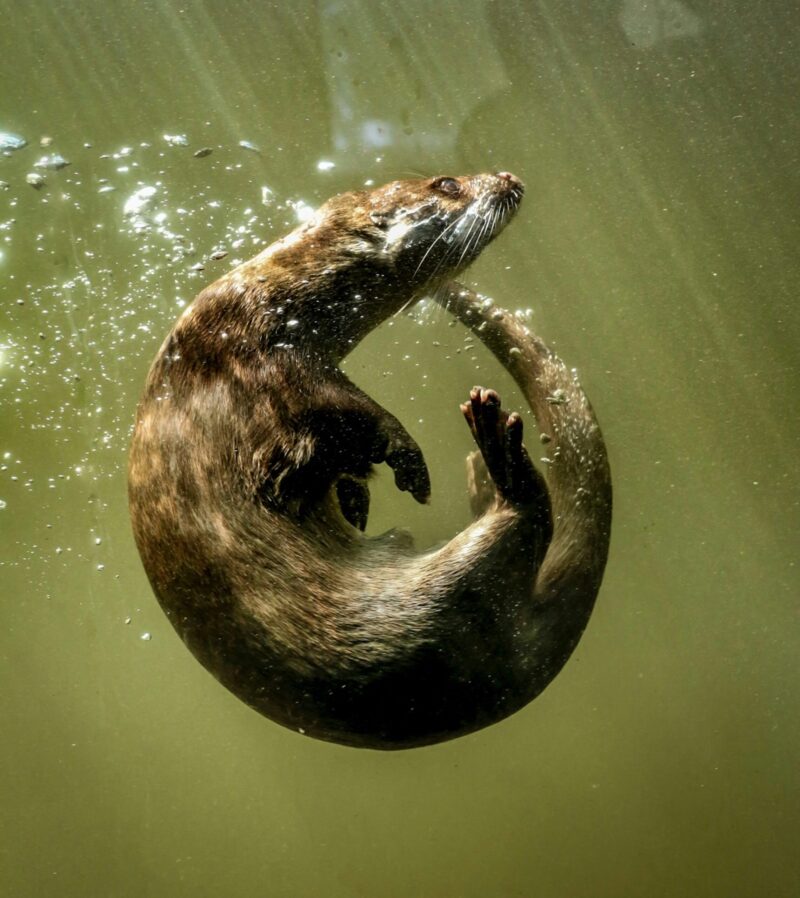
Otter behavior
Otters are also intelligent. Since clams, crustaceans and sea urchins are among their favorite dishes and they are hard-shelled, otters beat them against rocks on the shore. Or they place a rock on their belly – while swimming on their back – and open these organisms. Could we ask for any more tricks? A triple backflip, perhaps?
The dynamics of their bodies make them natural swimmers. For them, the most normal thing in the world is to float on the water on their backs, take a nap and open shells on their stomachs. Those are some good abs!
Another curious fact is that when they take naps while floating, they usually sleep on banks of algae or holding paws with each other (watch this sweet video), so that the current doesn’t take them very far. This way, they avoid waking up far away from others, perhaps getting lost.
These intelligent animals can also communicate through whistles, different ones depending on what they want to transmit to their group.

World-record fur and cold temperatures
No one knows how to insulate themselves from the cold better than otters. Their nostrils and ears close to prevent water from entering their bodies. In addition, they have thick fur equipped with filters that protects them from the freezing waters. The long outer hairs flatten and prevent water from reaching a lower layer of overlapping hairs. When they groom themselves, otters compact their inner fur so that it blocks the air, which provides them with perfect insulation.
It must be taken into account that sea otters don’t have a thick layer of blubber like other marine mammals such as whales have. So their fur is the only defense they have against losing heat in the water, where they spend almost all their time.
Otters have the densest fur in the world! It has up to a million hairs per square inch (150,000 hairs per square centimeter). Unfortunately, the fur is highly coveted and otters have been hunted almost to extinction in many places.
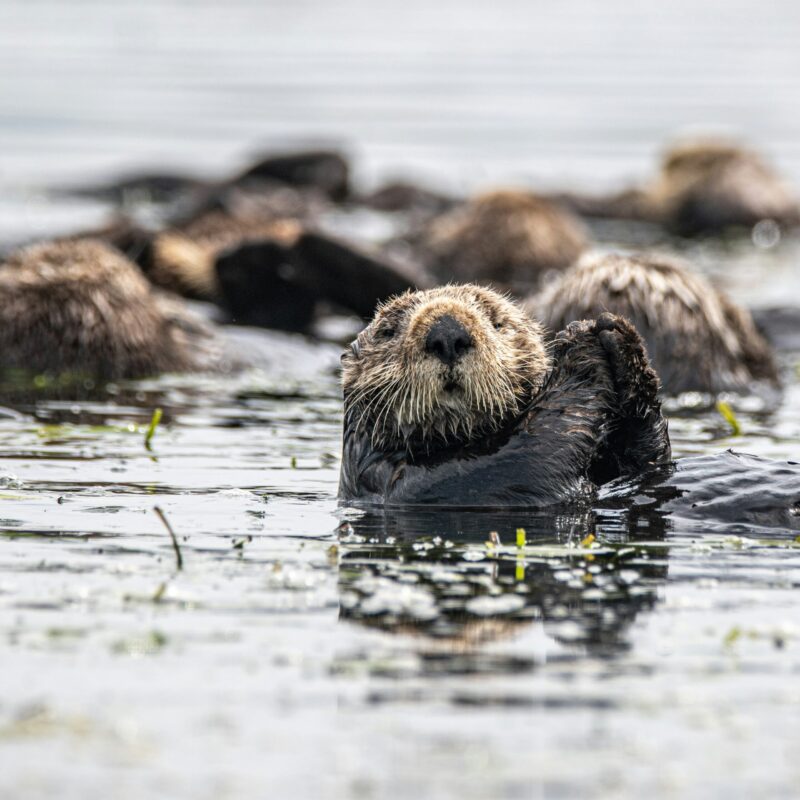
Life on land and baby otters
Although they could spend their entire lives in the water, otters also live on land. They sometimes come out of the water to rest, then seek shelter in underground holes, rock crevices, root cavities or simply dense vegetation along the coast.
Most otter species come to land to give birth in dens, which have sometimes been used by other animals such as beavers. Sea otters are the exception. They give birth in water. By the way, river otters don’t reproduce until they are at least five years old.
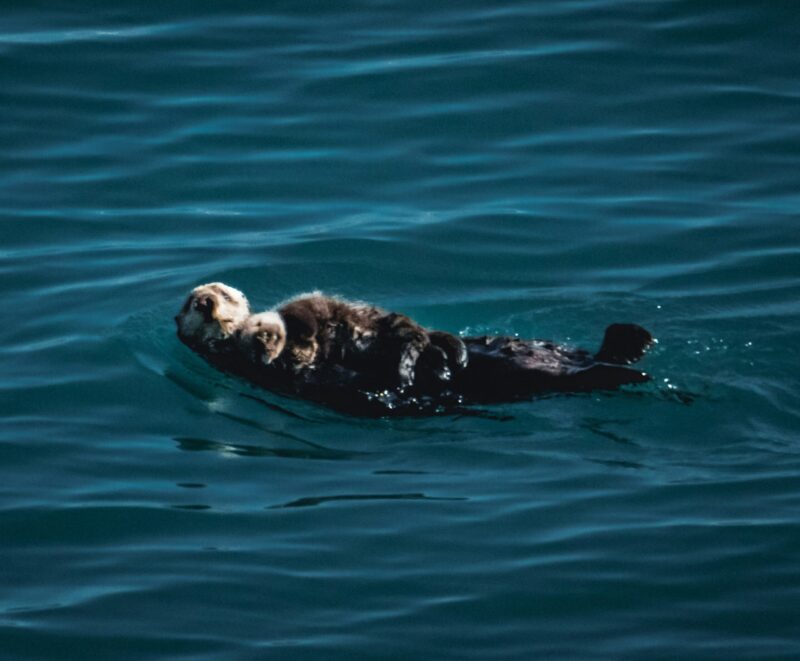
A female otter has a gestation period of two months for smaller species and five months for sea otters. Babies (called pups or kittens) are born weighing only 0.08 ounces (128 grams) for smaller species and 5 pounds (2 kg) for sea otters. All otters generally have one to three pups per litter.
Since they are mammals, females have a placenta and mammary glands that are used to feed their young. River otter babies are born with their eyes closed, without teeth and almost motionless, so it is important that the mother care for them and feed them for many weeks. The eyes open around one month of age. At two months, the pups begin to swim.
In the case of sea otters, the pups are born in the water with their eyes open. They have extra-fluffy fur that helps them float. However, it is also important that their mothers take care of them for several weeks. In fact, they often place them on their bellies while they are floating so they can take care of them.
At one year of age the pups leave their mother. From two to five years of age they will be ready to have their own babies. Otters live around 12 years and they usually have only one partner throughout their lives.
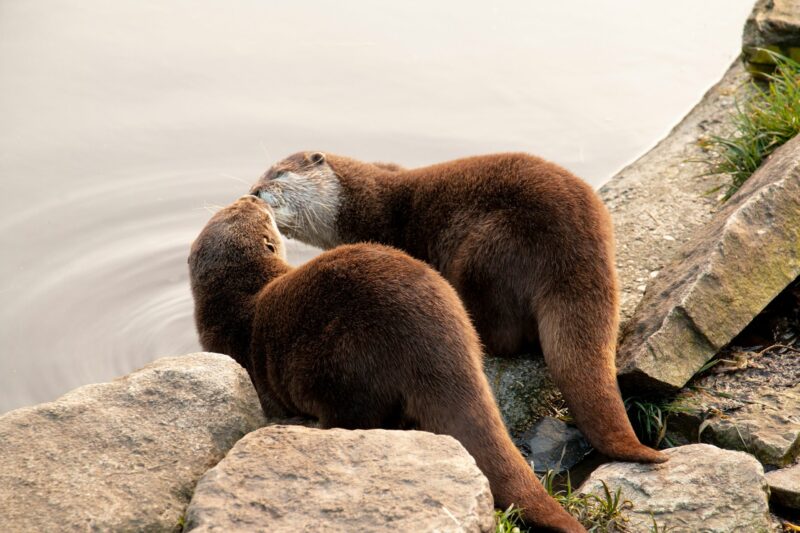
Ryan Hyde/ Unsplash.
Dangers otters face
Otters are docile animals that don’t usually attack without warning, but they are territorial and may have fights with members of their own species. However, they normally coexist with animals of other species without problems.
Despite being docile animals that are not afraid of humans, it is recommended to watch them from afar and not disturb them in their habitats. Otters can get stressed and are essential to the ecosystems in which they live.
For example, the sea otter feeds on the sea urchin, and the sea urchin in turn feeds on algae. The presence of the otter contributes to the recovery of kelp forests by controlling the sea urchin population.
Unfortunately, otters and their relatives have been hunted for their fur, many to the point of near-extinction. Despite regulations designed to protect them, many species remain endangered due to pollution, habitat loss, pesticides, and conflicts with fishermen who kill them for eating fish. Asian otter species also face threats such as the illegal pet trade.
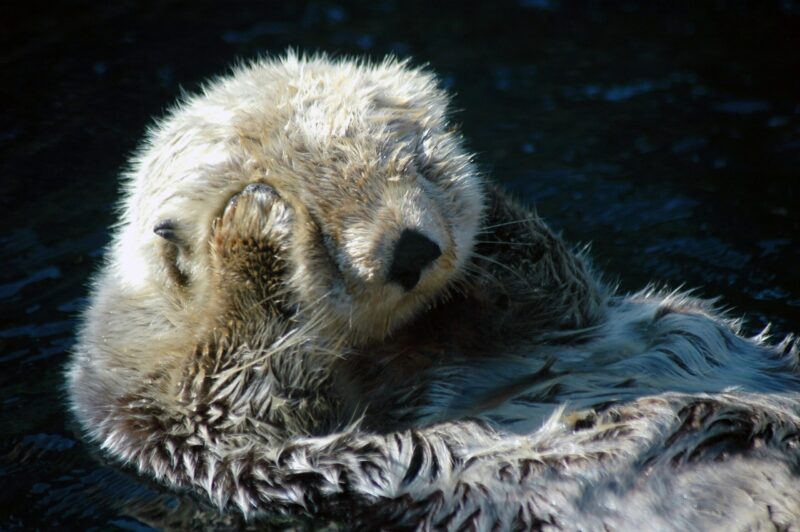
Bottom line: Otters are cute, fluffy, smart and good swimmers. They are incredible creatures. If you haven’t fallen in love with them yet, here are some reasons why you should.
Sea turtles are as old as dinosaurs: Lifeform of the week
Water lilies, beautiful and colorful: Lifeform of the week
The post Otters are our cutest and fluffiest lifeform of the week first appeared on EarthSky.
from EarthSky https://ift.tt/K8mEuck

Otters are mammals that belong to the mustelid family (Mustelidae). They share a category with the weasel, the badger and the mink, among others. Most are small, with short ears and noses, elongated bodies, long tails, and soft, dense fur. Due to this cute appearance and, of course, a playful attitude, many people have fallen in love with these animals. Read some interesting facts about them here.
To date, 13 species of otters have been identified. Their sizes vary from about 20 to 70 inches (60 to 180 cm) and their weight ranges from about 45 to 65 pounds (20 to 30 kg). Their lifespan is up to 12 years.
Where to find them and feeding habits
Otters are found worldwide except for Australia and Antarctica. They live on both land and water, although they spend most of their time in water. Most of them live in freshwater rivers, lakes, and wetlands, but sea otters are found in the Pacific Ocean.
They are carnivorous mammals that feed on whatever is easiest to obtain. So, their diet often varies seasonally or locally depending on what prey is available. Otters have fangs and molars that help them hunt and feed on meat.
In freshwater ecosystems, they feed on a wide variety of prey such as fish, crabs, mussels, mollusks, crustaceans, small mammals, birds and frogs. Sea otters eat a wide range of marine animals, including mussels, clams, urchins, crabs, snails and around 40 other marine species. In addition, otters are greedy for food and feed almost all day, consuming between 15% and 25% of their body weight each day.

Otter anatomy
Otters use their eyesight to chase fish, and their mouths and front legs to hunt them. They also use their manual dexterity to search for crayfish among the rocks. Sight is their most important sense when hunting. They can even correct the refraction caused by the change from the terrestrial environment to the aquatic environment. Simply amazing.
Likewise, they have sensory hairs on their snout, called vibrissae. These are stiff hairs, or whiskers, that some animals (especially mammals) have as a tactile, sensory element that helps them hunt. The vibrissae have sensitive roots that allow land animals to detect air currents, and aquatic animals to detect vibrations in the water.

After an otter captures its prey between the teeth or front legs, the prey is consumed in the water or on the shore. River otters hunt best in shallow water, although they are good swimmers. In fact, these animals are capable of diving up to 100 feet (30 meters) deep. They can even reach a speed of up to 9 miles per hour (14 kph) and can stay underwater without breathing for up to 8 minutes.
Their powerful hind legs are long, flattened and completely webbed; that anatomy helps them propel themselves through the water. They even have a fifth toe that helps them swim more easily, although it makes it difficult for them to move on land. The front legs are short and have retractable claws, which are useful to grab slippery prey.

Otter behavior
Otters are also intelligent. Since clams, crustaceans and sea urchins are among their favorite dishes and they are hard-shelled, otters beat them against rocks on the shore. Or they place a rock on their belly – while swimming on their back – and open these organisms. Could we ask for any more tricks? A triple backflip, perhaps?
The dynamics of their bodies make them natural swimmers. For them, the most normal thing in the world is to float on the water on their backs, take a nap and open shells on their stomachs. Those are some good abs!
Another curious fact is that when they take naps while floating, they usually sleep on banks of algae or holding paws with each other (watch this sweet video), so that the current doesn’t take them very far. This way, they avoid waking up far away from others, perhaps getting lost.
These intelligent animals can also communicate through whistles, different ones depending on what they want to transmit to their group.

World-record fur and cold temperatures
No one knows how to insulate themselves from the cold better than otters. Their nostrils and ears close to prevent water from entering their bodies. In addition, they have thick fur equipped with filters that protects them from the freezing waters. The long outer hairs flatten and prevent water from reaching a lower layer of overlapping hairs. When they groom themselves, otters compact their inner fur so that it blocks the air, which provides them with perfect insulation.
It must be taken into account that sea otters don’t have a thick layer of blubber like other marine mammals such as whales have. So their fur is the only defense they have against losing heat in the water, where they spend almost all their time.
Otters have the densest fur in the world! It has up to a million hairs per square inch (150,000 hairs per square centimeter). Unfortunately, the fur is highly coveted and otters have been hunted almost to extinction in many places.

Life on land and baby otters
Although they could spend their entire lives in the water, otters also live on land. They sometimes come out of the water to rest, then seek shelter in underground holes, rock crevices, root cavities or simply dense vegetation along the coast.
Most otter species come to land to give birth in dens, which have sometimes been used by other animals such as beavers. Sea otters are the exception. They give birth in water. By the way, river otters don’t reproduce until they are at least five years old.

A female otter has a gestation period of two months for smaller species and five months for sea otters. Babies (called pups or kittens) are born weighing only 0.08 ounces (128 grams) for smaller species and 5 pounds (2 kg) for sea otters. All otters generally have one to three pups per litter.
Since they are mammals, females have a placenta and mammary glands that are used to feed their young. River otter babies are born with their eyes closed, without teeth and almost motionless, so it is important that the mother care for them and feed them for many weeks. The eyes open around one month of age. At two months, the pups begin to swim.
In the case of sea otters, the pups are born in the water with their eyes open. They have extra-fluffy fur that helps them float. However, it is also important that their mothers take care of them for several weeks. In fact, they often place them on their bellies while they are floating so they can take care of them.
At one year of age the pups leave their mother. From two to five years of age they will be ready to have their own babies. Otters live around 12 years and they usually have only one partner throughout their lives.

Ryan Hyde/ Unsplash.
Dangers otters face
Otters are docile animals that don’t usually attack without warning, but they are territorial and may have fights with members of their own species. However, they normally coexist with animals of other species without problems.
Despite being docile animals that are not afraid of humans, it is recommended to watch them from afar and not disturb them in their habitats. Otters can get stressed and are essential to the ecosystems in which they live.
For example, the sea otter feeds on the sea urchin, and the sea urchin in turn feeds on algae. The presence of the otter contributes to the recovery of kelp forests by controlling the sea urchin population.
Unfortunately, otters and their relatives have been hunted for their fur, many to the point of near-extinction. Despite regulations designed to protect them, many species remain endangered due to pollution, habitat loss, pesticides, and conflicts with fishermen who kill them for eating fish. Asian otter species also face threats such as the illegal pet trade.

Bottom line: Otters are cute, fluffy, smart and good swimmers. They are incredible creatures. If you haven’t fallen in love with them yet, here are some reasons why you should.
Sea turtles are as old as dinosaurs: Lifeform of the week
Water lilies, beautiful and colorful: Lifeform of the week
The post Otters are our cutest and fluffiest lifeform of the week first appeared on EarthSky.
from EarthSky https://ift.tt/K8mEuck

Aucun commentaire:
Enregistrer un commentaire